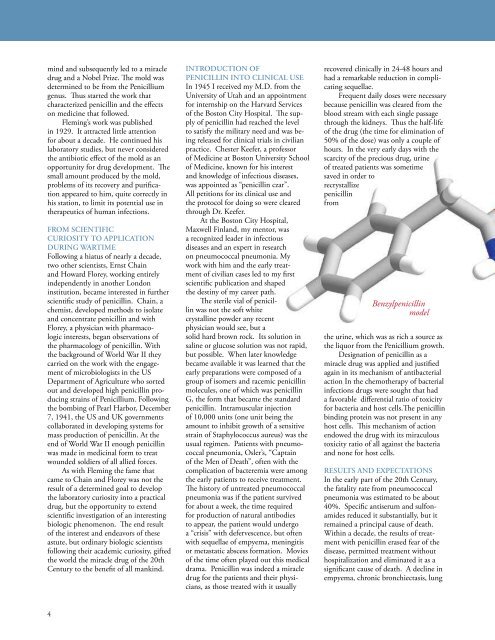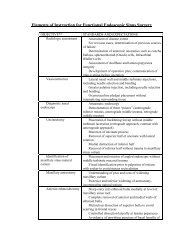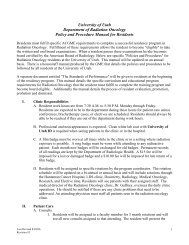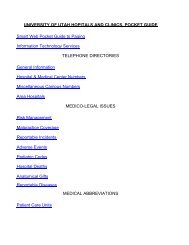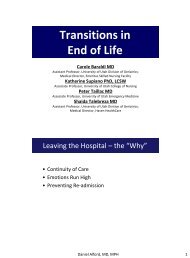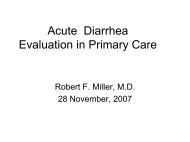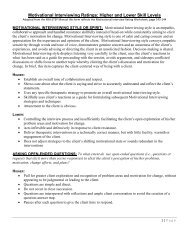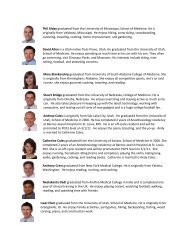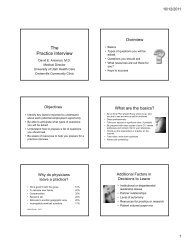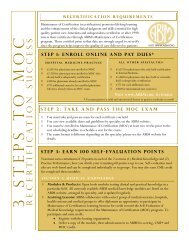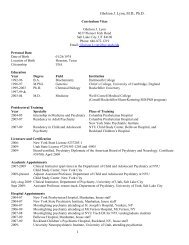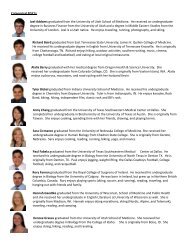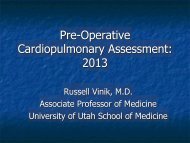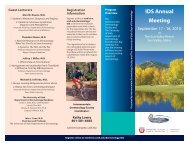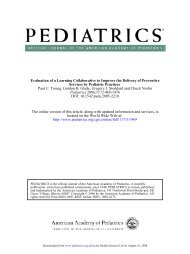Winter 2008/2009 - University of Utah - School of Medicine
Winter 2008/2009 - University of Utah - School of Medicine
Winter 2008/2009 - University of Utah - School of Medicine
Create successful ePaper yourself
Turn your PDF publications into a flip-book with our unique Google optimized e-Paper software.
mind and subsequently led to a miracle<br />
drug and a Nobel Prize. The mold was<br />
determined to be from the Penicillium<br />
genus. Thus started the work that<br />
characterized penicillin and the effects<br />
on medicine that followed.<br />
Fleming’s work was published<br />
in 1929. It attracted little attention<br />
for about a decade. He continued his<br />
laboratory studies, but never considered<br />
the antibiotic effect <strong>of</strong> the mold as an<br />
opportunity for drug development. The<br />
small amount produced by the mold,<br />
problems <strong>of</strong> its recovery and purification<br />
appeared to him, quite correctly in<br />
his station, to limit its potential use in<br />
therapeutics <strong>of</strong> human infections.<br />
FROM SCIENTIFIC<br />
CURIOSITY TO APPLICATION<br />
DURING WARTIME<br />
Following a hiatus <strong>of</strong> nearly a decade,<br />
two other scientists, Ernst Chain<br />
and Howard Florey, working entirely<br />
independently in another London<br />
institution, became interested in further<br />
scientific study <strong>of</strong> penicillin. Chain, a<br />
chemist, developed methods to isolate<br />
and concentrate penicillin and with<br />
Florey, a physician with pharmacologic<br />
interests, began observations <strong>of</strong><br />
the pharmacology <strong>of</strong> penicillin. With<br />
the background <strong>of</strong> World War II they<br />
carried on the work with the engagement<br />
<strong>of</strong> microbiologists in the US<br />
Department <strong>of</strong> Agriculture who sorted<br />
out and developed high penicillin producing<br />
strains <strong>of</strong> Penicillium. Following<br />
the bombing <strong>of</strong> Pearl Harbor, December<br />
7, 1941, the US and UK governments<br />
collaborated in developing systems for<br />
mass production <strong>of</strong> penicillin. At the<br />
end <strong>of</strong> World War II enough penicillin<br />
was made in medicinal form to treat<br />
wounded soldiers <strong>of</strong> all allied forces.<br />
As with Fleming the fame that<br />
came to Chain and Florey was not the<br />
result <strong>of</strong> a determined goal to develop<br />
the laboratory curiosity into a practical<br />
drug, but the opportunity to extend<br />
scientific investigation <strong>of</strong> an interesting<br />
biologic phenomenon. The end result<br />
<strong>of</strong> the interest and endeavors <strong>of</strong> these<br />
astute, but ordinary biologic scientists<br />
following their academic curiosity, gifted<br />
the world the miracle drug <strong>of</strong> the 20th<br />
Century to the benefit <strong>of</strong> all mankind.<br />
INTRODUCTION OF<br />
PENICILLIN INTO CLINICAL USE<br />
In 1945 I received my M.D. from the<br />
<strong>University</strong> <strong>of</strong> <strong>Utah</strong> and an appointment<br />
for internship on the Harvard Services<br />
<strong>of</strong> the Boston City Hospital. The supply<br />
<strong>of</strong> penicillin had reached the level<br />
to satisfy the military need and was being<br />
released for clinical trials in civilian<br />
practice. Chester Keefer, a pr<strong>of</strong>essor<br />
<strong>of</strong> <strong>Medicine</strong> at Boston <strong>University</strong> <strong>School</strong><br />
<strong>of</strong> <strong>Medicine</strong>, known for his interest<br />
and knowledge <strong>of</strong> infectious diseases,<br />
was appointed as “penicillin czar”.<br />
All petitions for its clinical use and<br />
the protocol for doing so were cleared<br />
through Dr. Keefer.<br />
At the Boston City Hospital,<br />
Maxwell Finland, my mentor, was<br />
a recognized leader in infectious<br />
diseases and an expert in research<br />
on pneumococcal pneumonia. My<br />
work with him and the early treatment<br />
<strong>of</strong> civilian cases led to my first<br />
scientific publication and shaped<br />
the destiny <strong>of</strong> my career path.<br />
The sterile vial <strong>of</strong> penicillin<br />
was not the s<strong>of</strong>t white<br />
crystalline powder any recent<br />
physician would see, but a<br />
solid hard brown rock. Its solution in<br />
saline or glucose solution was not rapid,<br />
but possible. When later knowledge<br />
became available it was learned that the<br />
early preparations were composed <strong>of</strong> a<br />
group <strong>of</strong> isomers and racemic penicillin<br />
molecules, one <strong>of</strong> which was penicillin<br />
G, the form that became the standard<br />
penicillin. Intramuscular injection<br />
<strong>of</strong> 10,000 units (one unit being the<br />
amount to inhibit growth <strong>of</strong> a sensitive<br />
strain <strong>of</strong> Staphylococcus aureus) was the<br />
usual regimen. Patients with pneumococcal<br />
pneumonia, Osler’s, “Captain<br />
<strong>of</strong> the Men <strong>of</strong> Death”, <strong>of</strong>ten with the<br />
complication <strong>of</strong> bacteremia were among<br />
the early patients to receive treatment.<br />
The history <strong>of</strong> untreated pneumococcal<br />
pneumonia was if the patient survived<br />
for about a week, the time required<br />
for production <strong>of</strong> natural antibodies<br />
to appear, the patient would undergo<br />
a “crisis” with defervescence, but <strong>of</strong>ten<br />
with sequellae <strong>of</strong> empyema, meningitis<br />
or metastatic abscess formation. Movies<br />
<strong>of</strong> the time <strong>of</strong>ten played out this medical<br />
drama. Penicillin was indeed a miracle<br />
drug for the patients and their physicians,<br />
as those treated with it usually<br />
recovered clinically in 24-48 hours and<br />
had a remarkable reduction in complicating<br />
sequellae.<br />
Frequent daily doses were necessary<br />
because penicillin was cleared from the<br />
blood stream with each single passage<br />
through the kidneys. Thus the half-life<br />
<strong>of</strong> the drug (the time for elimination <strong>of</strong><br />
50% <strong>of</strong> the dose) was only a couple <strong>of</strong><br />
hours. In the very early days with the<br />
scarcity <strong>of</strong> the precious drug, urine<br />
<strong>of</strong> treated patients was sometime<br />
saved in order to<br />
recrystallize<br />
penicillin<br />
from<br />
Benzylpenicillin<br />
model<br />
the urine, which was as rich a source as<br />
the liquor from the Penicillium growth.<br />
Designation <strong>of</strong> penicillin as a<br />
miracle drug was applied and justified<br />
again in its mechanism <strong>of</strong> antibacterial<br />
action In the chemotherapy <strong>of</strong> bacterial<br />
infections drugs were sought that had<br />
a favorable differential ratio <strong>of</strong> toxicity<br />
for bacteria and host cells.The penicillin<br />
binding protein was not present in any<br />
host cells. This mechanism <strong>of</strong> action<br />
endowed the drug with its miraculous<br />
toxicity ratio <strong>of</strong> all against the bacteria<br />
and none for host cells.<br />
RESULTS AND EXPECTATIONS<br />
In the early part <strong>of</strong> the 20th Century,<br />
the fatality rate from pneumococcal<br />
pneumonia was estimated to be about<br />
40%. Specific antiserum and sulfonamides<br />
reduced it substantially, but it<br />
remained a principal cause <strong>of</strong> death.<br />
Within a decade, the results <strong>of</strong> treatment<br />
with penicillin erased fear <strong>of</strong> the<br />
disease, permitted treatment without<br />
hospitalization and eliminated it as a<br />
significant cause <strong>of</strong> death. A decline in<br />
empyema, chronic bronchiectasis, lung<br />
abscess, purulent sinusitis and other sites<br />
<strong>of</strong> local respiratory infection followed.<br />
Other infections caused by organisms<br />
<strong>of</strong> somewhat less susceptibility to<br />
penicillin were treated successfully<br />
as doses <strong>of</strong> millions <strong>of</strong> units replaced<br />
the initial use <strong>of</strong> a few thousand.<br />
Decreased frequency, severity and<br />
fatality across the spectrum <strong>of</strong> the most<br />
common severe bacterial infections<br />
became an accepted expectation. .<br />
When penicillin was introduced<br />
in 1945, fatalities from rheumatic<br />
fever in the United States<br />
exceeded 2,000<br />
per year. Within 25 years, with a much<br />
larger population, there were fewer than<br />
100 recorded fatalities; today the fatality<br />
rate is less than 1 per 300,000 population.<br />
The reduction in the prevalence <strong>of</strong><br />
acute rheumatic fever since the introduction<br />
<strong>of</strong> penicillin is estimated at<br />
99.9% with an equally dramatic decline<br />
in rheumatic heart disease and<br />
other sequellae.<br />
Treponema pallidum, the cause<br />
<strong>of</strong> syphilis is among the most sensitive <strong>of</strong><br />
microorganism to penicillin. Treatment<br />
<strong>of</strong> acute, congenital and neurosyphilis<br />
with penicillin yielded impressive cures<br />
in each <strong>of</strong> these syndromes. Latency,<br />
failed case detection and social behavior<br />
regarding sexually transmitted diseases,<br />
including gonorrhea, have combined to<br />
restrict the efficacy <strong>of</strong> effective treatment<br />
to eradicate or more completely diminish<br />
their prevalence. A side effect <strong>of</strong> this<br />
success is a cavalier loss <strong>of</strong> fear <strong>of</strong> acquiring<br />
infection which has permitted cyclic<br />
increases in infection rates to continue.<br />
Unfortunately human behavior is the<br />
first trump people have exercised<br />
in defeating the potential benefits<br />
<strong>of</strong> the miracle means <strong>of</strong> treatment<br />
and prevention <strong>of</strong> infections with<br />
susceptible bacteria.<br />
IRRATIONAL EUPHORIA<br />
With recognition <strong>of</strong> all its miraculous<br />
properties and the emergent capability<br />
<strong>of</strong> fermentation chemists began to<br />
produce large amounts <strong>of</strong> pure penicillin<br />
cheaply, and the expansion in world<br />
wide use <strong>of</strong> penicillin proceeded<br />
at a whirlwind rate. Indications<br />
for its use were broadened to<br />
include any whimper <strong>of</strong><br />
justification for treatment<br />
or prophylaxis<br />
<strong>of</strong> suspected bacterial<br />
infection.<br />
Within a quarter<br />
century after the introduction<br />
<strong>of</strong> penicillin, more<br />
than 90% <strong>of</strong> people in the<br />
developed countries <strong>of</strong>the<br />
world had received one or<br />
more courses <strong>of</strong> penicillin;<br />
it was found in sewer<br />
samples from urban<br />
areas and in up to<br />
10% <strong>of</strong> dairy milk<br />
samples, illustrating<br />
the spread <strong>of</strong> its use in veterinary<br />
medicine. Confidence in the drug was<br />
so high that even the placebo effect led<br />
some to the belief that in unknown<br />
ways penicillin was “just good for you”.<br />
The trend was an unquenchable social<br />
phenomenon with ineffectual academic<br />
restraints; some academic leaders even<br />
declared victory over infectious diseases,<br />
disbanding the academic specialty from<br />
their faculties. “Why take time in a<br />
crowded program and claim space in a<br />
building …for a field <strong>of</strong> medicine presently<br />
regarded as having only historical<br />
interest?” This quotation from Rene<br />
Dubos in 1954 captured the irrationality<br />
<strong>of</strong> the euphoria that had penetrated<br />
academia and was prevalent in all <strong>of</strong> the<br />
society during the last half <strong>of</strong> the twentieth<br />
century.<br />
The fictional term, “antibiotic last<br />
rites”, captured the universality <strong>of</strong> confidence<br />
in miraculous results <strong>of</strong> antibiotic<br />
treatment. The interaction <strong>of</strong> medical<br />
practice and human desire for perpetual<br />
health and longevity has shown it has<br />
consequences and lessons to be learned<br />
for application to the advances <strong>of</strong> the<br />
21st Century.<br />
The short sighted detriment <strong>of</strong><br />
the social attitudes <strong>of</strong> the period was<br />
effective in diminishing vigilance in<br />
the epidemiology <strong>of</strong> infectious diseases,<br />
and slowing acquisition <strong>of</strong> academic<br />
knowledge <strong>of</strong> primary host pathophysiology<br />
in susceptibility and immunity<br />
to infections <strong>of</strong> various types. With the<br />
high expectations that chemotherapy<br />
was sufficient to control infectious<br />
diseases the well developed state public<br />
health departments which informed<br />
and served the public in control <strong>of</strong><br />
community epidemics were dismantled<br />
and fiscally starved to a shadow <strong>of</strong> their<br />
earlier prominence. Fear and need for<br />
preparations for continuing epidemics<br />
and pandemics is once again being realized<br />
and expressed.<br />
Perhaps the most severe ultimate<br />
cost <strong>of</strong> the irrational euphoria ignited<br />
by penicillin and its antibiotic sequitors,<br />
was prophylaxis and trial and error<br />
therapy, and a utopian aim to have<br />
broad antibiotic regimens that would<br />
prevent and/or cure the entire spectrum<br />
<strong>of</strong> human infections. It set the stage for<br />
the emergence <strong>of</strong> penicillin resistance<br />
and sequentially more extensive and<br />
complete resistance to other antibiotics<br />
that followed. That is the yield being<br />
harvested in the present era.<br />
A NEW PERSPECTIVE<br />
The antibiotic story <strong>of</strong> the 21st Century<br />
will not have the aura nor realize the<br />
fullness <strong>of</strong> the benefits, at least not with<br />
the same drugs, that were so miraculously<br />
effective during the golden last half <strong>of</strong><br />
the 20th Century. It is likely that new<br />
and perhaps equally miraculous chemotherapeutic<br />
agents can be developed<br />
using the advanced knowledge gained<br />
about the sophisticated molecular biology<br />
<strong>of</strong> bacteria, viruses and fungi and<br />
new capabilities in microbial genetics<br />
and combinatorial chemistry. The<br />
expectations and accepted patterns <strong>of</strong><br />
their use will need to be more specifically<br />
directed and general use against a<br />
broad spectrum <strong>of</strong> targets limited, if the<br />
medical pr<strong>of</strong>ession and public learned<br />
the lessons from use <strong>of</strong> the miracle<br />
drug that heralded the 20th Century<br />
era--penicillin.<br />
4 5


